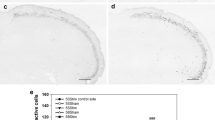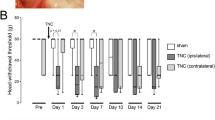Abstract
Previous studies have demonstrated that there is an increase in oxidative stress in the cerebral cortex of rats after repeated painful stimulation and that long-lasting pain increases the production of superoxide ion (O2 −), nitric oxide and peroxynitrite due to the activation of AMPA and NMDA receptors. The purpose of the present study was to evaluate the possible role of O2 − in the transmission of oro-facial pain. Formaldehyde 1% was injected subcutaneously into one vibrissal pad of adult male Sprague-Dawley rats as a model of persistent pain, then O2 − production and superoxide dismutase (SOD) activity were evaluated in the left and right spinal trigeminal nuclei. O2 − production was revealed using dihidroetidium (DHE) injected at 10 or 45 min after the formalin injection in conscious or anaesthetized rats. A histochemical assay for SOD was performed to evaluate the activity of SOD at 10 min after the formalin injection. The results showed a significant increase in O2 − production in the homolateral nucleus at 45 min. However, there was no significant difference between the two sides at 10 min after the formalin injection. No significant difference was observed in SOD activity between the two sides of the spinal trigeminal nucleus. This study demonstrated that there is an increased production of O2 − in the second phase but not in the first phase of the formalin test; thus O2 − is involved in pain induced by inflammation, but not in acute pain.






Similar content being viewed by others
References
Breimer L (1991) Repair of DNA damage induced by reactive oxygen species. Free Radic Res Commun 14:159–171
Davies KJA (1993) Protein modification by oxidants and the role of proteolytic enzymes. Biochem Soc Trans 21:346–353
Halliwell B, Chirico S (1993) Lipid peroxidation: its mechanism, measurement and significance. Am J Clin Nutr 57:715–725
Callaghan MJ, Ceradini DJ, Gurtner GC (2005) Hyperglycemia-induced reactive oxygen species and impaired endothelial progenitor cell function. Antioxid Redox Signal 7:1476–1482
Weidig P, McMaster D, Bayraktutan U (2004) High glucose mediates pro-oxidant and antioxidant enzyme activities in coronary endothelial cells. Diabetes Obes Metab 6:432–441
Jackson AL, Loeb LA (2001) The contribution of endogenous sources of DNA damage to the multiple mutations in cancer. Mutat Res 477:7–21
Burdon RH (1995) Superoxide and hydrogen peroxide in relation to mammalian cell proliferation. Free Radic Biol Med 18:775–794
Valko M, Rhodes CJ, Moncol J, Izakovic M, Mazur M (2006) Free radicals, metals and antioxidants in oxidative stress-induced cancer. Chem Biol Interact 160:1–40
Adams JD Jr, Odunze IN (1991) Oxygen free radicals and Parkinson’s disease. Free Radic Biol Med 10:161–169
Lovell MA, Markesbery WR (2007) Oxidative DNA damage in mild cognitive impairment and late-stage Alzheimer’s disease. Nucleic Acids Res 35:7497–7504 (Review)
Barj G (2004) Free radicals and aging. Trends Neurosci 27:595–600
Andersen JK (2004) Oxidative stress in neurodegeneration: cause or consequence? Nat Med 10:18–25
Guzik TJ, Sadowski J, Guzik B, Jopek A, Kapelak B, Przybylowski P, Wierzbicki K, Korbut R, Harrison DG, Channon KM (2006) Coronary artery superoxide production and nox isoform expression in human coronary artery disease. Arterioscler Thromb Vasc Biol 26:333–339
Loffredo L, Marcoccia A, Pignatelli P, Andreozzi P, Borgia MC, Cangemi R, Chiarotti F, Violi F (2007) Oxidative-stress-mediated arterial dysfunction in patients with peripheral arterial disease. Eur Heart J 28:608–612
Beckman KB, Ames BN (1998) The free radical theory of aging matures. Physiol Rev 78:547–581
Kregel KC, Zhang HJ (2007) An integrated view of oxidative stress in aging: basic mechanisms, functional effects, and pathological considerations. Am J Physiol Regul Integr Comp Physiol 292:18–36
Green DR, Reed JC (1998) Mitochondria and apoptosis. Science 281:1309–1312
Ushio-Fukai M, Alexander RW (2004) Reactive oxygen species as mediators of angiogenesis signaling: role of NAD(P)H oxidase. Mol Cell Biochem 264:85–97
Colton CA, Fagni L, Gilbert D (1989) The action of hydrogen peroxide on paired pulse and long-term potentiation in the hippocampus. Free Radic Biol Med 7:3–8
Viggiano A, Viggiano E, Monda M, Viggiano A, Ascione S, Amaro S, De Luca B (2007) Intracerebroventricular injection of oxidant and antioxidant molecules affects long-term potentiation in urethane anaesthetized rats. Physiol Res 57:269–273
Pellmar TC (1987) Peroxide alters neuronal excitability in the CA1 region of guinea pig hippocampus in vitro. Neuroscience 23:447–456
Auerbach JM, Segal M (1997) Peroxide modulation of slow onset potentiation in rat hippocampus. J Neurosci 17:8695–8701
Rokyta R, Holecek V, Pekárkova I, Krejcová J, Racek J, Trefil L, Yamamotová A (2003) Free radicals after painful stimulation are influenced by antioxidants and analgesics. Neuro Endocrinol Lett 24:304–309
Reiter R, Tang L, Garcia JJ, Muńos-Hoyos A (1997) Pharmacological actions of melatonin in oxygen radical pathophysiology. Life Sci 60:2255–2271
Puig S, Sarkin LS (1995) Formalin-evoked activity in identified primary afferent fibers: systemic lidocaine suppresses phase-2 activity. Pain 64:345–355
Raboisson P, Dallel R (2004) The orofacial formalin test. Neurosci Biobehav Rev 28:219–226
Dubuisson D, Dennis SG (1997) The formalin test: a quantitative study of the analgesic effects of morphine, meperidine, and brain stem stimulation in rats and cats. Pain 4:161–174
Dennis SG, Melzack R (1979) Self-mutilation after dorsal rhizotomy in rats: effects of prior pain and pattern of root lesions. Exp Neurol 65:412–421
Choi HS, Lee HJ, Jung CY, Ju JS, Park JS, Ahn DK (2003) Central cyclooxygenase-2 participates in interleukin-1 beta-induced hyperalgesia in the orofacial formalin test of freely moving rats. Neurosci Lett 352:187–190
Viggiano A, Monda M, Viggiano A, Chiefari M, Aurilio C, De Luca B (2004) Evidence that GABAergic neurons in the spinal trigeminal nucleus are involved in the transmission of inflammatory pain in the rat: a microdialysis and pharmacological study. Eur J Pharmacol 496:87–92
Azerad J, Woda A, Albe-Fessard D (1982) Physiological properties of neurons in different parts of the cat trigeminal sensory complex. Brain Res 246:7–21
Dallel R, Raboisson P, Woda A, Sessle BJ (1990) Properties of nociceptive and non-nociceptive neurons in trigeminal subnucleus oralis of the rat. Brain Res 521:95–106
Dubner R, Bennett GJ (1983) Spinal and trigeminal mechanisms of nociception. Annu Rev Neurosci 6:381–418 (Review)
Viggiano A, Monda M, Viggiano Al, Viggiano D, Viaggiano E, Chiefari M, Ausilio C, De Luca B (2005) Trigeminal pain transmission requires reactive oxygen species production. Brain Res 1050:72–78
Paxinos G, Watson C (1986) The rat brain in stereotaxic coordinates (2nd edn). Academic Press, New York
Tal M (1996) A novel antioxidant alleviates heat hyperalgesia in rats with an experimental painful peripheral neuropathy. Neuroreport 7:1382–1384
Salvemini D, Wang ZQ, Zweier JL, Samouilov A, Macarthur H, Misko TP, Currie MG, Cuzzocrea S, Sikorski JA, Riley DP (1999) A nonpeptidyl mimic of superoxide dismutase with therapeutic activity in rats. Science 286:304–306
Kim HK, Park SK, Zhou JL, Taglialatela G, Chung K, Coggeshall RE, Chung JM (2004) Reactive oxygen species (ROS) play an important role in a rat model of neuropathic pain. Pain 111:116–124
Wang ZQ, Porreca F, Cuzzocrea S, Galen K, Lightfoot R, Masini E, Muscoli C, Mollace V, Ndengele M, Ischiropoulos H, Salvemini D (2004) A newly identified role for superoxide in inflammatory pain. J Pharmacol Exp Ther 309:869–878
Kim HK, Kim JH, Gao X, Zhou JL, Lee I, Chung K, Chung JM (2006) Analgesic effect of vitamin E is mediated by reducing central sensitization in neuropathic pain. Pain 122:53–62
Woolf CJ, Thompson SWN (1991) The induction and maintenance of central sensitization is dependent on N-methyl-d-aspartic acid receptor activation; implication for the treatment of post-injury pain hypersensitivity states. Pain 44:293–299
Dubner R, Ruda MA (1992) Activity-dependent neuronal plasticity following tissue injury and inflammation. Trends Neurosci 15:96–103
Coderre TJ, Melzack R (1992) The contribution of excitatory amino acids to central sensitization and persistent nociception after formalin-induced tissue injury. J Neurosci 12:3665–3670
Ren K, Hylden JLK, Williams GM, Ruda MA, Dubner R (1992) The effects of a non-competitive NMDA receptor antagonist, MK-801, on behavioral hyperalgesia and dorsal horn neuronal activity in rats with unilateral inflammation. Pain 50:331–344
Ma QP, Woolf CJ (1996) Progressive tactile hypersensitivity: an inflammation-induced incremental increase in the excitability of the spinal cord. Pain 67:97–106
Cerne R, Jiang M, Randic M (1992) Cyclic adenosine 3′5′-monophosphate potentiates excitatory amino acid and synaptic responses of rat spinal dorsal horn neurons. Brain Res 596:111–123
Li P, Zhuo M (1998) Silent glutamatergic synapses and nociception in mammalian spinal cord. Nature 393:695–698
Christie JM, Wenthold RJ, Monaghan DT (1999) Insulin causes a transient tyrosine phosphorylation of NR2A and NR2B NMDA receptor subunits in rat hippocampus. J Neurochem 72:1523–1528
Gao X, Kim HK, Chung JM, Chung K (2005) Enhancement of NMDA receptor phosphorylation of the spinal dorsal horn and nucleus gracilis neurons in neuropathic rats. Pain 116:62–72
Gao X, Kim HK, Chung JM, Chung K (2007) Reactive oxygen species (ROS) are involved in enhancement of NMDA-receptor phosphorylation in animal models of pain. Pain 131:262–271
Klann E, Roberson ED, Knapp LT, Sweatt JD (1998) A role for superoxide in protein kinase C activation and induction of long-term potentiation. J Biol Chem 273:4516–4522
Li L, Shou Y, Borowitz JL, Isom GE (2001) Reactive oxygen species mediate pyridostigmine-induced neuronal apoptosis: involvement of muscarinic and NMDA receptors. Toxicol Appl Pharmacol 177:17–25
Kim HY, Wang J, Lu Y, Chung JM, Chung K (2009) Superoxide signaling in pain is independent of nitric oxide signaling. Neuroreport 20:1424–1428
Doyle T, Bryant L, Batinic-Haberle I, Little J, Cuzzocrea S, Masini E, Spasojevic I, Salvemini D (2009) Supraspinal inactivation of mitochondrial superoxide dismutase is a source of peroxynitrite in the development of morphine antinociceptive tolerance. Neurosci 164:702–710
Muscoli C, Mollace V, Wheatley J, Masini E, Ndengele M, Wang ZQ, Salvemini D (2004) Superoxide-mediated nitration of spinal manganese superoxide dismutase: a novel pathway in N-methyl-d-aspartate-mediated hyperalgesia. Pain 111:96–103
Dalo NL, Larson AA (1990) Effects of urethane and ketamine on substance P- and excitatory amino acid-induced behavior in mice. Eur J Pharmacol 184:173–177
Salo DC, Pacifici RE, Lin SW, Giulivi C, Davies KJA (1990) Superoxide dismutase undergoes proteolysis and fragmentation following oxidative modification and inactivation. J Biol Chem 256:11919–11927
Viggiano A, Viggiano D, Viggiano A, De Luca B (2003) Quantitative histochemical assay for superoxide dismutase in rat brain. J Histochem Cytochem 51:865–871
Author information
Authors and Affiliations
Corresponding author
Rights and permissions
About this article
Cite this article
Viggiano, E., Monda, M., Viggiano, A. et al. Persistent facial pain increases superoxide anion production in the spinal trigeminal nucleus. Mol Cell Biochem 339, 149–154 (2010). https://doi.org/10.1007/s11010-009-0378-9
Received:
Accepted:
Published:
Issue Date:
DOI: https://doi.org/10.1007/s11010-009-0378-9




